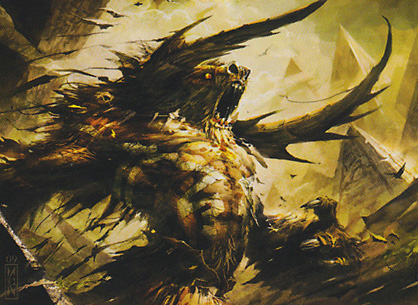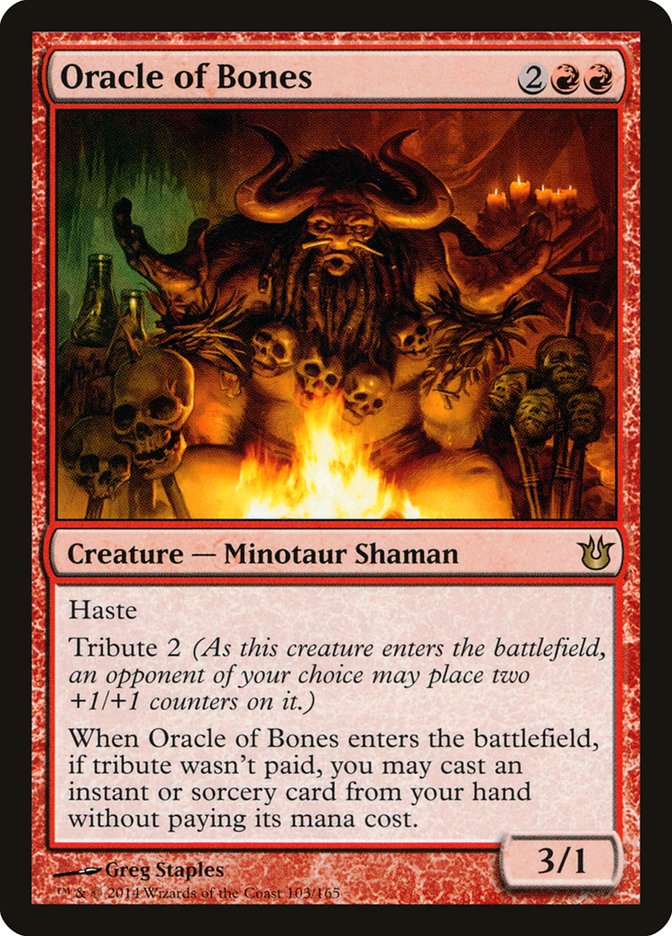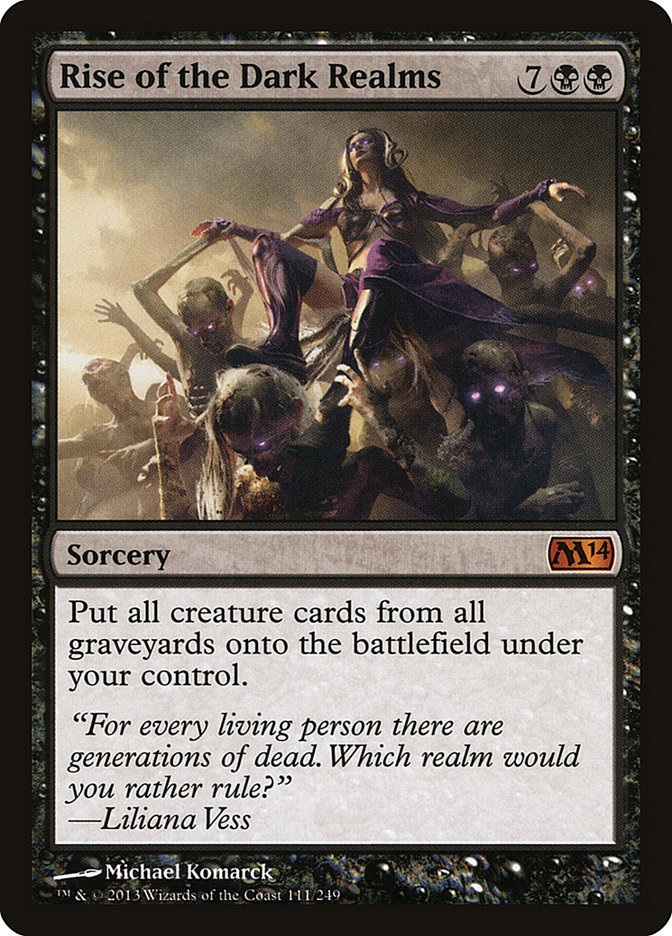Sometimes building and playing a Magic deck is a subtle task that involves precise testing and metagame research. Sometimes, though, you just have to take the bull by the horns.

Minotaurs are a staple in the trope of Cretan and thus Greek mythology; anyone who’s ever read a book on mythology, seen a hokey dramatic rendition of one on the stage or screen, or is just a maze-o-phile (correct scientific term) is aware of this pointy horned half-man. With Theros blowing in from, well, whatever the Dominarian equivalent of the Aegean Sea is, we get to see this clan featured in a way that gets us tribal folks excited. The last time we saw Minotaurs get a nod outside of a creature type line was, what, Homelands? It’s about time.
People get excited when lords come around for normally unsupported tribes, so Rageblood Shaman got a lot of people excited for Minotaur tribal. For those who were already pumped, Born of the Gods brought us several key players, some exciting and some unexciting.
I have several decks to share with you today, and all of them are tribal in some way. Minotaurs are brawlers first and foremost, though, so I’ll show you my version of the aggro decks I’ve seen floating around.
Creatures (31)
- 4 Boros Reckoner
- 4 Rageblood Shaman
- 1 Underworld Cerberus
- 2 Purphoros, God of the Forge
- 4 Kragma Warcaller
- 4 Fanatic of Mogis
- 4 Deathbellow Raider
- 4 Ragemonger
- 4 Felhide Brawler
Lands (25)
Spells (4)
Sideboard

This aggro deck is going to look like most; I have only one set of spells maindeck (Boros Charm), but every creature pulls its weight. Even the lowly Felhide Brawler is pretty interesting as a 3/3 trampler for one mana (taking lords and Ragemonger’s "familiar" ability into account), and every creature is like that. In case of danger, the deck’s playset of Mutavault can ably finish the job. Naturally, they receive all the benefits of every other hard Minotaur in the deck. It really is a great little land.
From the board, I figured removal would be more important than burn and wanted to highlight the potential for Legion’s Initiative in this list. It saves everything but Felhide Brawler, and it acts as a power-boosting anthem when you don’t need it. You can activate it to emulate vigilance if you need to. Because of Ragemonger’s potential to let you cast Minotaurs with mana to spare and colored mana no less, it’s easy to keep mana available to blink the team.
This is my version, and I’ve heard some friends have taken down FNMs (or at the least finished in the cash range) with a deck like this. Theirs admittedly are more seasoned and tailored, but this took the 31 creature base and added the flare that I felt it needed. The lands will prove to be the most expensive part, but if you have those, picking up the Minotaurs is a cinch.
There is one Minotaur that doesn’t show up in that list that I believe deserves a mention:
Hidden amongst the spiffy and impressive cards of Born of the Gods is this little trinket. As I’ve said in previous articles, tribute as a mechanic leaves the choice of bonus in the hands of the opponent, who is bound to pick that which is most beneficial to them. In the right deck, though, Oracle of Bones is a very real double-edged sword. If you pay the tribute, you’re taking five damage immediately. If you let your opponent cast a spell for free, it’ll gain you tempo, and you’ll still be threatening haste damage. Most of the time you’ll get a 5/3 haste creature for four, and that’s still pretty solid in my book.
R/W Burn on the back of Boros Charm and Warleader’s Helix makes for an excited and slightly more versatile approach than the traditional mono-red route, and threatening a free burn spell is a decidedly exciting route to take.
Creatures (6)
Planeswalkers (2)
Lands (24)
Spells (28)
- 4 Magma Jet
- 4 Skullcrack
- 4 Boros Charm
- 4 Warleader's Helix
- 4 Chained to the Rocks
- 4 Lightning Strike
- 4 Searing Blood
Sideboard

My list is loosely based on a GP Top 8 deck built by Darin Minard. I loved this list the moment I saw it in December, and I’ve been fiddling with and testing it ever since. I almost played it at the SCG Standard Open in Indianapolis last month, but I chickened out.
As you can see, I stabled Young Pyromancer to bring Oracle in. Against Drown in Sorrow; Master of Waves; Brave the Elements; and Nylea, God of the Hunt, Young Pyromancer just seems outclassed at the moment. Even Golgari Charm, a maindeckable card in Standard, lights up the Pyromancer and its tokens. Oracle of Bones seems a much better fit. Searing Blood replaces Shock, which functions similarly with greater potential upside. Otherwise, the deck is pretty familiar. The lack of Stormbreath Dragon is intentional. By the time Stormbreath hits them for four, Oracle could have hit them for ten. Evasion and protection come at a cost, but I feel like it pays off here.
From the sideboard, I’m really anxious to try Satyr Firedancer. It’s probably too slow to be effective, but being able to punch your opponent with a Boros Charm and bust their Blood Baron of Vizkopa is pretty spicy. You can even kill a Fiendslayer Paladin that way!
Fated Conflagration is a good card; there are a lot of x/5s that burn decks in the current format can’t answer with just one card. For the clean and tidy cost of four mana, Fated Conflagration can break an Elspeth, Sun’s Champion or Jace, Architect of Thought that uses the first ability; an unprotected Aetherling; an Obzedat, Ghost Council; an Advent of the Wurm token; or a Polukranos, World Eater. Each of these targets can present a real threat to traditional burn decks, and the ability to gain additional scry benefit makes this a great choice for midrange or planeswalker-based decks. In fact, Vraska the Unseen is the only planeswalker in Standard who can avoid an instant death from this card upon activating its plus ability for the first time.
Okay, Gideon, Champion of Justice can kind of.
Burning Earth still seems relevant enough against any non-devotion deck, and the other two spells are for fun. Toil // Trouble is a great finisher, or you can use Toil as Divination to draw you more burn. Wear // Tear, well, does its boring little job just fine.
Having said all that, I’ve been leading you all astray a bit.
I like each of these decks and feel like both are viable, but I actually want to show you my fun Minotaur deck. It’s about as deep as the Aegean Sea, and it’s even got some blue to boot.
Remember how Oracle of Bones can cast a burn spell for free? There’s something else that it can cast for free.
We’re plunging into the maze.
Creatures (28)
- 4 Lotleth Troll
- 4 Rageblood Shaman
- 4 Sylvan Caryatid
- 4 Kragma Warcaller
- 4 Fanatic of Mogis
- 4 Ragemonger
- 4 Oracle of Bones
Planeswalkers (3)
Lands (22)
Spells (7)

Hmm, that looks a little weird. Let’s break it down for a second.
The purpose of the deck is to cast Rise of the Dark Realms with enough reanimation targets to kill your opponent on the spot. This can be accomplished in several ways. Kragma Warcaller gives every Minotaur you control haste as well as a power boost, and multiples of this boost stack, making three Warcallers lethal by themselves. Fanatic of Mogis, whose devotion trigger counts on resolution, can burn your opponent to cinders in one shot thanks to the double-red cost of many Minotaurs. In multiples, you get exponential bang!
Casting a nine-mana black spell has never been easy, but we have two things that help: Oracle of Bones and Unexpected Results. Since most people will opt for the tribute (at least in game 2), the Simic spell will be your best ticket to casting this spell on time. Sylvan Caryatid, a necessary evil in a four-color deck, makes a vital appearance. Twenty Minotaurs can be loaded into the graveyard, and Lotleth Troll helps you get them there. Discard in response to your stacked Rise of the Dark Realms and they’ll all come back to play!
Garruk, Caller of Beasts is the Minotaur tribe’s best friend, and I’m not just talking about this deck. Minotaurs suffer from severe deficiency in card advantage. Ragemonger drastically reduces the cost of the creature spells you cast, so it’s best to have a full grip of creatures as often as possible. That’s how G/R Monsters, G/R Devotion, Elves, and a variety of other creature-centric decks stay afloat against removal and permission.
Garruk makes an appearance here as a way to fill your grip continually; unlike traditional Reanimator decks, I opted away from the iffy Grisly Salvage and other enablers, choosing power level over graveyard interaction. If worse comes to worst, he can be an engine for a traditional aggro deck where you can find and cast a bunch of brawlers if you can’t find the sorceries you need.
One note on the mana base. You’ll notice this deck plays no scry lands, and that’s intentional. First, because combo decks rely on speed and consistency, we need to stay away from tapped lands as much as possible. We need color, and we need it now. Second, Unexpected Growth shuffles your deck anyway; although you can still play a scry land after you cast the spell, this may not be optimal, and the first point trumps the minimal advantage granted by the scry.
The sideboard is a bit messy. Burning-Tree Emissary is a great free 2/2 when you need to manufacture blockers against an aggro deck, and if you end up raising it from the dead, it can return some of your mana investment on the enabler. Slaughter Games is just a catchall; I’m not sure if there’s Reanimator hate out there anymore, but you might find yourself with a card you can’t beat. With Sylvan Caryatid, you can still cast this on their turn 2 and wrench the best card out of their deck, whether it’s Sphinx’s Revelation or Gray Merchant of Asphodel. This will often be a game 3 sideboard choice if at all.
The rest of the creatures fit specific roles. Courser of Kruphix, perhaps the most powerful green midrange card in Standard (yeah, I said it), helps aggro matches a ton; Unexpected Results can get a land for free, so that’s something to remember! Sylvan Primordial is a control monster, smashing Detention Spheres, planeswalkers and Underworld Connections with glee. I’m surprised it’s taken so long for the best Primordial to catch on in Standard, but it’s here to stay. Shadowborn Demon is the Sylvan Primordial for midrange creature-based decks. It’s enormous and can smash most anything. The disadvantage of having to sacrifice each turn could be seen as a benefit in a Reanimator deck, as was perhaps the intention.
This is a slightly unorthodox combo deck; you won’t really "combo out" on turn 3 or 4, but instead you’ll protect yourself and build the alpha strike for that one turn. Garruk, Caller of Beasts provides a traditional route to victory, while reanimation provides instant punishment for Supreme Verdict and Mizzium Mortars. It’s a longshot, but it might be just thing you need to look at Standard in a new way!
While we’re on a tribal note, I want to share my updated Sliver list with you. I’ve playtested it a lot since I wrote about it in November. After some tweaking, here’s where it stands today.
Creatures (30)
- 4 Blur Sliver
- 3 Striking Sliver
- 4 Thorncaster Sliver
- 4 Megantic Sliver
- 4 Predatory Sliver
- 4 Galerider Sliver
- 3 Syphon Sliver
- 4 Manaweft Sliver
Planeswalkers (3)
Lands (24)
Spells (3)

Not to be rude or pushy, but it is in my humble opinion that you should be playing this deck.
In my mind, Sliver Lining has all the aspects of a fun deck: it’s competitive, is creature based, and has complex interactions. The three C’s if you will (something I didn’t just make up). This deck’s mana and consistency are surprisingly strong, and you have a tool for every board state. Nothing feels better than tapping out for a Megantic Sliver on turn 4 or 5 and smashing your opponent with a handful of 4/4 and 5/5 flyers. Garruk, Caller of Beasts is amazing; I find myself frequently casting him then immediately using his second ability to drop a Megantic Sliver and swing for a lot.
The sideboard, although it contains only one Sliver, contains other relevant creatures. Ruric Thar, the Unbowed, is so awesome against grindy control decks, especially Maze’s End. How’s that Fog plan looking now? Underworld Cerberus is great against U/W Control, automatically refilling your hand after a board wipe. Lotleth Troll, although he looks silly, is an awesome tool against Mono-Black Devotion, where you can turn your potentially underpowered creatures into a protectable +1/+1 counter. Golgari Charm is the crux of the sideboard though; it has so many uses against nearly every deck, whether it’s Mono-White Aggro, Mono-Blue Devotion, or any green deck that relies on Boon Satyr and Elvish Mystic to keep the pressure on.
This is a well-tuned deck in this form, and I highly recommend you try it this weekend. It has been able to win at least one match against every archetype I tested against, which ran the gamut from hyperaggressive aggro to mind-numbing control. All of the decks I’ve given you have seen play in my testing time, and I’ve loved each one. But if you have to play just one, try the latter two!
Next weekend brings Grand Prix Richmond, another opportunity for Modern to shine. I am hoping to go, and if I can make the nine-hour drive, I’ll be there with a fun brew that I’ve been testing for the last couple months. Maybe it’ll get there.
Do you have any tribal brews swirling around right now? Did a Modern tribal deck open up thanks to the recent additions? Is Reanimator in any form viable in Standard at the moment or did we lose too many pieces with September’s rotation?


